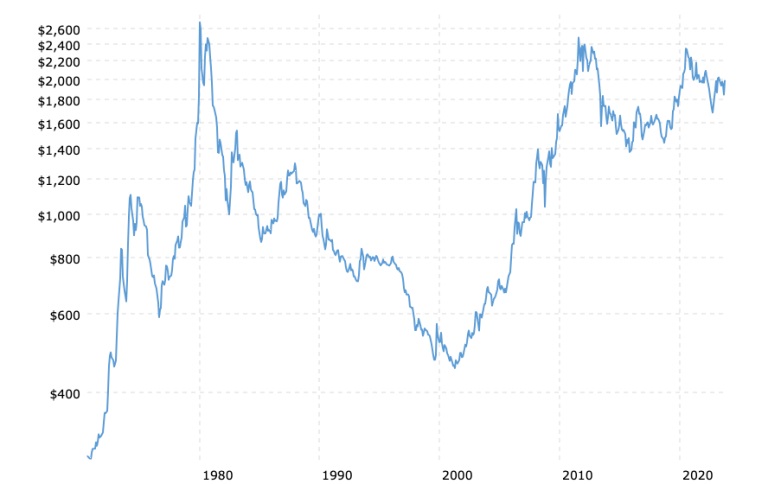What we know about gold is simple and straight forward. Gold is real money and a long-term store of value.
Gold’s value is in its use as money. Its price has nothing do with its value. In fact, the price of gold has nothing to do with gold at all.
The higher price of gold over time is a reflection of the loss of purchasing power in the U.S. dollar.
The U.S. dollar and all paper currencies are substitutes for real money, i.e., gold. All governments inflate and destroy their own currencies.
As the dollar and other currencies lose purchasing power, the ‘price’ of gold increases. This price increase does not mean that gold is more valuable.
The value of gold is constant and stable. As original money, gold was the measure of value for everything else. Prices for various goods and services were denominated in fractional weights of gold (ounces, grams, grains).
In order to encourage the use of dollars, a ratio of convertibility was fixed at $20.67 to one ounce of gold.
With the inception of the Federal Reserve and central banking, the use of fiat money was expanded and amplified. Eventually, the United States government suspended convertibility and cancelled any official link between the U.S. dollar and gold.
Subsequently, the gold price rose dramatically between 1971 and 1980. The increase in the gold price to an average monthly closing price of $677 in January 1980 reflected an accumulated loss of purchasing power in the U.S. dollar totaling ninety-seven percent.
This represented several decades of ongoing inflation and its effects which had previously not been factored into the fixed gold price. For the gold price it was a period of catch up and realignment with the actual purchasing power of the U.S. dollar.
There was nothing predictive or subjective about it. The value of gold had not changed. The change in its price was due to the effects of inflation that had previously occurred and their impact on the purchasing power of the U.S. dollar. (see Gold Is Cheaper Now Than In 1980)
GOLD SINCE 1980
When the gold price peaked in 2011 at $1895 ounce, it represented a nearly ninety-nine percent loss of purchasing power in the U.S. dollar and accounted for the effects of inflation that had occurred between 1980 and 2011. It was another catch-up period for the gold price.
Likewise, the 2020 gold price high of $2048 was a reflection of further loss of dollar purchasing power and confirmed an accumulated total loss of ninety-nine percent.
The price of gold increases in hindsight to reflect the effects of previous inflation that have shown up in a loss of U.S. dollar purchasing power. The three major peaks (1980, 2011, and 2020) in the gold price are shown on the chart below…
Gold Prices (inflation-adjusted) 1970-2023
GOLD AFTER 2023 – NEW HIGHS?
Predictions for new highs in gold should be viewed with skepticism. Any substantial and lasting new highs in the gold price will come only after a further loss of purchasing power in the U.S. dollar that is maintained for a reasonable period of time.
Inflation never stops. Its effects are sometimes quite mild and, at other times, more severe. Even so, gold might take several years to reflect the ongoing, cumulative effects of inflation.
For example, gold has approached (and briefly exceeded) its nominal peak price of $2048 several times since August 2020. However, the effects of inflation and loss of U.S. dollar purchasing power since then are such that gold would need to be $2340 in current dollars just to match that previous peak.
At $1950-80, gold is almost $400 oz. below its August 2020 peak. That doesn’t sound like gold is “knocking at the door of new highs”. Any declines in the gold price would widen the gap.
WHAT WE DON’T KNOW ABOUT GOLD
“What we don’t know about gold” might be better phrased as ‘what we don’t know about the U.S. dollar and the effects of inflation”.
We don’t know the end result of the Fed’s attempt to raise interest rates to a more normal level. What is more important is that we don’t know how the U.S. dollar will respond and whether or not it can continue its pattern of relative strength versus other currencies and gold.
We also cannot see the effects of inflation before they show up in the system, regardless of how bad or how mild they might be.
After the hugely inflationary efforts of the Federal Reserve in 2008-2010, most expected a big jump in the effects of inflation and a speedy resumption of economic activity. Not so. It took almost a full decade to get back on track. And, even then, the effects of inflation remained muted.
After Covid, the effects of inflation combined with disruptions in the supply chain sent consumer prices up dramatically. This led to a new round of projections and predictions for the price of gold.
CONCLUSION
The potential for extreme inflation is a very real possibility. So, too, is the potential for deflation. Then, again, things could continue in muted fashion for years. We won’t know until after the fact.
The gold price will not reflect any of those scenarios until after they happen. Gold is not forward-looking.
In addition, as can be seen on the chart above, there can be long periods of time before the gold price catches up to the effects of previous inflation.
To whatever extent the price of gold moves higher, it is only to catch up to the effects of previous inflation and to compensate for the actual loss of purchasing power in the U.S. dollar. (see Gold Bulls Are Too Price-Dependent)
Kelsey Williams is the author of two books: INFLATION, WHAT IT IS, WHAT IT ISN’T, AND WHO’S RESPONSIBLE FOR IT and ALL HAIL THE FED!
**********




